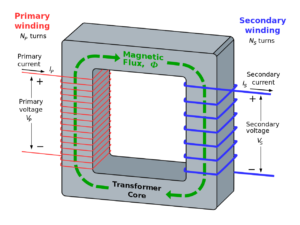- September 13, 2017
- 2 Comments
- In Miscellaneous
- By Steven Winter Associates
Sometimes a significant source of energy inefficiency in a building can be hiding in a place difficult to detect. In some buildings, a single transformer can have a substantial impact on electrical consumption.

click to enlarge
Some Background
Transformers are responsible for stepping the incoming voltage to a building up or down depending on the design, intended use, or connected equipment. A standard electrical socket in a US home or office will deliver 110-120 volts AC. Some appliances require 240 V instead. Large mechanical equipment, such as the air handling units, distribution pumps and chillers found in commercial or multifamily buildings may require 460 V. In buildings where the incoming voltage from the utility does not match the voltage required by connected equipment, a transformer is used to deliver the necessary voltage. The voltage entering the transformer is called the primary voltage and the voltage delivered by the transformer to the facility’s equipment is called the secondary voltage.
The Problem
Steven Winter Associates (SWA) recently performed retro-commissioning at a building receiving an incoming voltage from the utility that was higher than initially anticipated. The transformer for that facility had not been selected for this higher voltage. Because the transformer’s primary voltage was higher than anticipated, the transformer’s secondary voltage was also higher than anticipated. All of the building equipment served by this transformer was receiving a voltage greater than what the equipment was rated for.
A secondary voltage outside of design range will impact any connected devices, including motors and lighting. Lighting fixtures receiving excess or insufficient voltage will burn out faster than fixtures receiving the correct voltage. To learn more about how lighting fixtures can fail, follow this link. A low voltage can cause a motor’s current draw to spike, leading to excessive heat generated at the motor. This excessive heat will shorten the motor’s lifespan. When a motor receives a voltage 10% higher than its design value, it can experience a decrease in efficiency of up to 3%.
At the building SWA retro-commissioned, the delivered voltage was 9% higher than design. The resulting decrease in efficiency, carried across all motors in a facility, can add up to a significant amount of excess electrical consumption. In the building where we discovered that this issue was occurring, the elevated secondary voltage was responsible for 85,000 kWh per year of excess electrical consumption, adding $15,000 to the building’s annual electricity costs.
At this building, a quick voltage reading was all it took to identify an energy savings potential of 85,000 kWh per year. Plenty of buildings don’t perform these voltage readings at all, and may be missing out on the significant savings a correction could provide.
Written by:

Maria Rode, Mechanical Engineer

Jason Boccio, Mechanical Engineer

Best title ever.
Thanks for pointing out that a transformer is responsible for stepping the incoming voltage to a building. I would imagine that businesses would need a power transformer to cover many different fields of application. I guess they should look for a reliable company that can provide power transformers with high harmonic content.